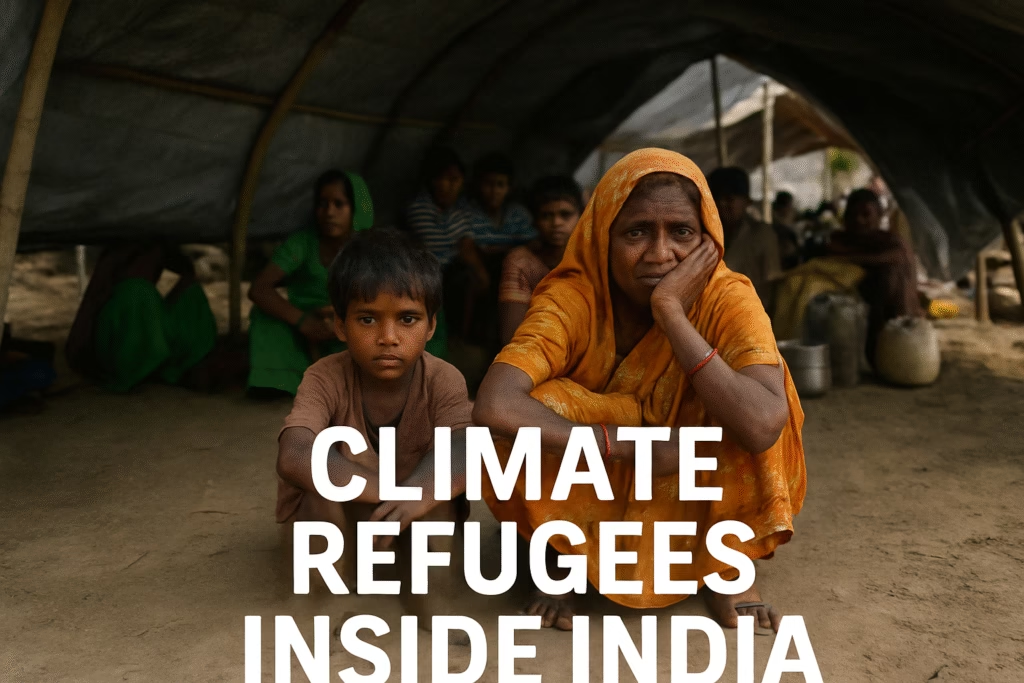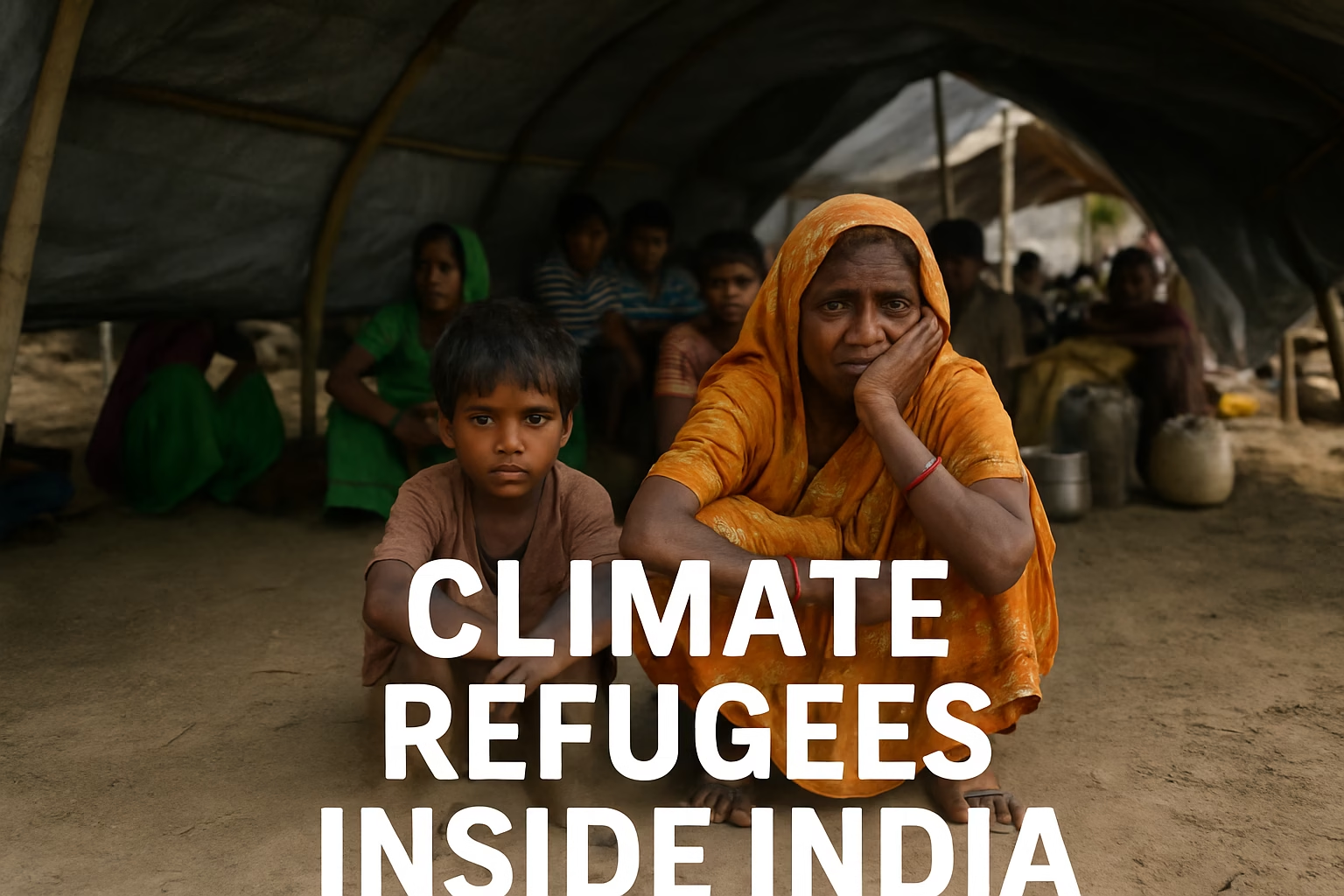Introduction: Who Are Climate Refugees?
When we think of refugees, we often imagine war zones and international borders. But there’s a quieter, more insidious crisis unfolding in our own backyard — climate refugees inside India. These are people who haven’t crossed borders but have been forcibly displaced from their homes due to floods, droughts, cyclones, sea-level rise, and other climate-related disasters. And the numbers are growing fast.
In the coming decades, India is likely to witness one of the world’s largest internal climate migrations. It’s not just a rural or coastal issue — it affects cities, livelihoods, and human dignity.

What Is Driving Climate Displacement in India?
1. Rising Sea Levels in Coastal States
States like West Bengal, Odisha, and Tamil Nadu are facing rising sea levels that threaten to engulf entire villages. The Sundarbans region, home to over 4.5 million people, is already seeing land loss and salinity intrusion. Families are abandoning homes, turning into climate refugees inside India without any formal recognition or support.
2. Floods in the North and Northeast
Bihar and Assam experience annual floods that displace millions. In 2023 alone, over 1.2 million people in Assam were affected by floods, many of whom had to flee without a plan or safety net. These victims are often relocated to makeshift camps or forced to migrate to cities, where they live in slums without basic amenities — again, the invisible climate refugees inside India.
3. Droughts and Desertification in Central India
Maharashtra, Madhya Pradesh, and Chhattisgarh are becoming hotter and drier. Farmers who rely on rain-fed agriculture are left with no choice but to abandon their land. Entire communities have migrated from drought-prone areas to urban centers in search of work, thus adding to the rising number of climate refugees inside India.
4. Cyclones in Eastern India
Cyclone Amphan (2020), Cyclone Yaas (2021), and Cyclone Biparjoy (2023) have caused massive destruction across Odisha and West Bengal. Each storm has uprooted hundreds of thousands. These aren’t isolated events but part of a disturbing pattern — increasing both in frequency and intensity due to climate change. More people are forced to flee, becoming climate refugees inside India.
Real Stories Behind the Numbers
Let’s meet Meena Devi from Bihar. Her house near the Kosi River was washed away in the 2022 floods. Today, she lives in a temporary settlement near Patna. Her children no longer go to school. Her husband, once a farmer, now works as a construction laborer for daily wages. “We didn’t run from war, but we lost everything,” she says. She is one of the thousands of climate refugees inside India, living a life in limbo.
In Maharashtra, 28-year-old Shankar left his village due to four failed monsoons. “Farming became impossible. There was no water, no food, only debt,” he recalls. He now works in a textile factory in Surat. Though he sends money home, he knows he may never return.
These are not just stories — they are the human face of climate migration.
Why Don’t We Call Them Refugees?
Internationally, the term “refugee” has legal protection under the UNHCR (United Nations High Commissioner for Refugees), but only for those fleeing persecution, not environmental disasters. That leaves climate refugees inside India in a grey zone. They are displaced, but they’re not officially recognized. They don’t get the rights, support, or protection they urgently need.
Impact on Urban India
As more rural populations are displaced, Indian cities are facing immense pressure. Mumbai, Delhi, Bengaluru, and Hyderabad are already struggling with housing shortages, water stress, and unemployment. The influx of climate refugees inside India adds another layer of complexity.
Without planning or support, this migration could turn into an urban humanitarian crisis. Slums will grow, resources will shrink, and tensions could rise if local populations feel threatened by the growing numbers of migrants.
Government Response: Is It Enough?
While India has climate action policies, the specific needs of climate refugees inside India are often overlooked. The National Disaster Management Authority (NDMA) focuses on immediate relief, but long-term rehabilitation is lacking.
Some positive efforts include:
- The Climate Resilient Cities Initiative
- Jal Shakti Abhiyan (Water conservation mission)
- Afforestation and carbon reduction goals
But unless these policies are directly linked to migration planning and human rehabilitation, the situation will only worsen. We need a national registry, relief framework, and legal protection for climate refugees inside India.
What Can Be Done?
1. Recognition and Legal Status
The government must formally recognize the status of climate refugees inside India and integrate them into national disaster and climate policies.
2. Climate-Resilient Infrastructure
Building flood-resistant housing, rainwater harvesting systems, and cyclone shelters can prevent displacement in vulnerable areas.
3. Livelihood Support
Programs that provide alternative employment and training for displaced farmers and laborers can reduce distress migration.
4. Urban Planning
Cities must prepare for an influx of climate refugees inside India by improving low-cost housing, water supply, and sanitation infrastructure.
5. Education and Healthcare Access
Children and families displaced due to climate events need access to schooling and medical care — not just emergency aid.
The Road Ahead
Climate change is no longer a distant threat. It is happening here, now — reshaping geography, displacing people, and testing our resilience. The crisis of climate refugees inside India will define the future of our cities, economy, and social fabric.
Ignoring it will only deepen inequality and conflict. But recognizing it gives us the power to act, plan, and protect those most vulnerable. Because climate justice isn’t just about carbon levels — it’s about human lives.
READ : 10 Most Dangerous Haunted Places in North India – PLEASE DON’T GO
Final Thoughts
India has a rich history of community resilience and adaptability. But to tackle the crisis of climate refugees inside India, we must blend compassion with policy, and urgency with innovation. These are not just numbers or nameless faces. They are families, workers, farmers, and children — citizens of India — whose futures depend on what we do today.
Let’s not wait for a flood, storm, or drought to wake us up. Let’s act now.
📌 Stay Updated
Bookmark Time of Hindustan for more Entertaining news.

